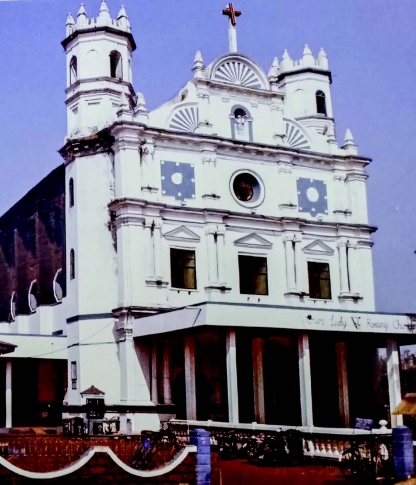
Frazer Andrade
Just like Nuvem was to the north, Návelim was a former ward of Márgão, down south. Both the villages, neither Nuvem nor Návelim, have comunidades of their own and are under the Márgão gãonkari. Návelim was always a part of Márgão, even though erected into a completely separate parish since the early Portuguese period. All community lands in Návelim still belong to the Comunidade de Márgão. From the beginning, Márgão constituted the only deanery of South Goa and comprised of 37 parishes including that of Návelim. Since Návelim was originally part of Márgão, it may have been separated into a new village at a later period, thus getting the name ‘Návelim’ which could have been derived from ‘nov (new) + hal’li (village). South Goa witnesses three feasts celebrated in a sequence. To begin with, the feast of the Infant Jesus in Colvá, followed by the feast of The Mother of the Poor, in Nuvem and ultimately, the Feast of Our Lady of the Rosary, in Návelim.
The Igreja de Nossa Senhora do Rosário de Návelim was established in the late 16th century in 1567, by Fr Jean de Sena, who was a French Jesuit, using funds raised from the local community. On May 23, 1606, the gãonkárs of Márgão, offered a plot in Návelim for the construction of a bigger edifice. Also, on October 11, 1606, Mária de Águiár donated a piece of land named ‘Tontem Cumbar-batta’. According to tradition, a merchant whose business was seeing bad days, entered the church one day as he passed by the church. He pledged to Our Lady that if his business flourished, he would make sure that the church was enlarged. His business did flourish and so he kept his word. He not only enlarged the church but also enshrined a new statue of Our Lady. He also had the Feast shifted from being celebrated on the first Sunday of October to being celebrated on the third Wednesday of November. He was also the one responsible for encouraging vendors to set up a fair on the occasion of the feast of Our Lady in Návelim.
Earlier, the Feast fair would comprise of just about three to four stalls and would last only for a day. The vendors didn’t stay overnight due to prevailing beliefs that the area around the church was the residing space for spirits. Gradually, the fair duration was increased to three days by Dr Francisco Salvador Gomes (father of Dr Francisco Luis Gomes), by motivating a few brave vendors to set up their stalls as part of the Feast fair.
The church was raided and looted by the Maratha troops in 1717 and 1739. During one of these raids, the image of Our Lady was taken to the city of Goa for safety reasons and was housed in the Carmel Convent there. It was brought back to Návelim only after the expulsion of all religious orders from Goa in 1835. The first vicar at this church was Fr Jean de Sena SJ while the last Jesuit Vicar was Fr Diego de Amaral, in 1759. In total, there were 22 Jesuit Vicars who served this Parish. The church was rebuilt in 1941 and a new bell was installed then. The originally built northern tower of the church bears the bell while the southern matching tower was added as late as 1980s by the then vicar of the church Fr Robert Váz. In Návelim, the feast of Our Lady of the Rosary is celebrated on the third Wednesday of November while throughout the world, the feast is celebrated on October 7.
Every year, on the first day of the novena of Our Lady of the Rosary, since the last 50 years or so, early in the morning at 3.30 am, a procession is held from the Capela de Nossa Senhora do Carmo in Teláulim to the Church of Our Lady of the Rosary. It was started during the tenure of Fr Cámilo Coutinho, who was the chaplain of Capela de Nossa Senhora do Carmo. The procession is referred to as ‘Vatinchem Pursanv’ or ‘Procissão de velas’, since people participating in this procession hold lit candles as they proceed to the Church in a meandering queue sparkling with the light of all the lit candles. In the procession, a statue of Our Lady of Fátima is carried to the church and a Mass is celebrated at the church at 5 am by the chaplain of the Capela.
Traditionally, the male gãokars from Teláulim would go to the Ghats (Belgão), a day before the Novena to source cattle to be sold during the feast fair. Just like the feast in Nuvem was known for cattle trade so was the feast in Návelim. Villagers would also get sack loads of other agricultural produce from the Ghats to be sold at the fair and on their return back would carry along goods like salt, dried fish and coconuts from Goa. Originally in the procession the statue of Our Lady of Mount Carmel was brought to the Church, which remained there until the Feast of Our Lady of the Rosary and was taken back to the chapel after the feast. This was done for safety reasons, to ensure that the statue from the chapel was safe at the church in the absence of the men of the village, who went to the Ghats for sourcing cattle which were traded at the church fair. It was recently that late Fr José Roque Cáetáno Pires substituted the statue of Our Lady of Mount Carmel with that of an image of Our Lady of Fátima, with help of the rejidor (notary) of Teláulim, José Minguel Pires de Menezes.
According to Crésçénçio Pereira, a resident of Návelim, the date of the Feast has been changed to the third Wednesday of November, since most of the villagers in Návelim were paddy cultivators. “Hence in the month of October, they would be completely engaged with harvesting works in their fields, and were not able to spare enough time to entertain their guests who dropped by on the occasion of the Feast. Also after harvesting their fields in October they would have sufficient money in hand to carry out the feast celebrations in full swing in the month of November,” says Crésçénçio.
